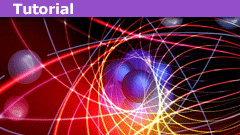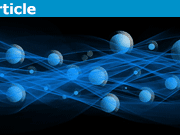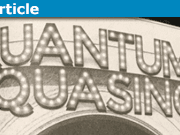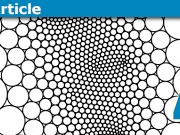The Classical Limit of Quantum Mechanical Commutator
The Classical Limit of Commutator (without fancy mathematics)
Quantum mechanics occupies a very unusual place among physical theories: It contains classical mechanics as a limiting case, yet at the same time it requires this limiting case for its own formulation.
Many textbooks on elementary QM show you how the Hamilton-Jacobi [tex]\frac{\partial S}{\partial t} + H \left( x , \frac{\partial S}{\partial x}\right) = 0,[/tex] shows up as the classical limit, ##\hbar \to 0## , of the Schrodinger wave equation [tex]i\hbar \frac{\partial \Psi}{\partial t} – H \left(x , – i \hbar \frac{\partial}{\partial x}\right) \Psi = 0.[/tex]Textbooks also state, but without proof, that the equation of motion of a classical observable [itex]A(x,p)[/itex],[tex]\begin{equation}\frac{d}{dt}A(x,p) = – \big\{ H , A \big\}(x,p) = \frac{\partial H}{\partial p}\frac{\partial A}{\partial x} – \frac{\partial H}{\partial x}\frac{\partial A}{\partial p},\end{equation}[/tex]is the classical limit of Heisenberg equation for the corresponding quantum observable ##\hat{A}## ,[tex]\begin{equation}\frac{d}{dt} \hat{A} = \frac{i}{\hbar} \big[ \hat{H} , \hat{A} \big] = \frac{i}{\hbar}\left(\hat{H} \hat{A} – \hat{A} \hat{H}\right).\end{equation}[/tex]Thus it must be true that[tex]\begin{equation}\lim_{\hbar \to 0} \frac{1}{i\hbar} \left( \hat{H} \hat{A} – \hat{A} \hat{H} \right) = \frac{\partial H}{\partial x} \frac{\partial A}{\partial p} – \frac{\partial H}{\partial p} \frac{\partial A}{\partial x}.\end{equation}[/tex]That is the commutator of two quantum operators in the classical limit approaches the Poisson bracket of the corresponding phase space functions. If you are (like I once was) puzzled by Eq(3) or struggled to prove it, then I should tell you that you are not the only one. In fact, in a letter to Pauli dated Oct 23rd 1925, even Heisenberg expressed his frustration by saying:
“But the worst thing is that I am unable to clarify the transition (of matrix mechanics) to the classical theory”
So, the purpose of this insight is to show you how to do the thing that Heisenberg was “unable to clarify” in his youth. Moreover, the proof of Eq(3) is going to be the one that I arrived at during my undergraduate years (long time ago). So, if you have taken QM1 you will have no problems with the mathematical and physical concepts I will be using bellow. Okay, let’s start by looking at the matrix element of the commutator ##\big[ \hat{A} , \hat{B} \big]## in the coordinate representation[tex]\begin{equation}\langle x |\big[ \hat{A} , \hat{B} \big]|y \rangle = \int dz \ \Big\{ \langle x |\hat{A}|z \rangle \langle z | \hat{B}|y \rangle – \langle x |\hat{B}|z \rangle \langle z | \hat{A}|y \rangle \Big\}.\end{equation}[/tex]Since each matrix element is a c-number, we may think of it as a “function” of two (coordinate) variables and write it as a function of the average of, and the difference between, the two coordinate:[tex]\begin{equation*}\langle x | \hat{A} | z \rangle = A \left( \frac{x + z}{2} , x – z \right),\end{equation*}[/tex][tex]\begin{equation*}\langle z | \hat{B} | y \rangle = B \left( \frac{z + y}{2} , z – y \right).\end{equation*}[/tex]The expressions for the other two matrix elements are obtained by simply letting ##A \leftrightarrow B## . Next, we expand the dependence on the coordinate differences in Fourier integrals[tex]\begin{equation}\langle x | \hat{A} | z \rangle = \frac{1}{2\pi \hbar} \int dp \ A \left( \frac{x + z}{2} , p \right) \ e^{\frac{i}{\hbar}(x – z)p},\end{equation}[/tex][tex]\begin{equation}\langle z | \hat{B} | y \rangle = \frac{1}{2\pi \hbar} \int d\bar{p} \ B \left( \frac{z + y}{2} , \bar{p} \right) \ e^{\frac{i}{\hbar}(z – y)\bar{p}}.\end{equation}[/tex]These are the famous Weyl quantization rule: for every function ##A(x,p)## on phase space, Weyl associates an operator ##\hat{A}## whose matrix element is given by Eq(5). The phase-space function ##A(x,p)## is called the operator symbol, or Weyl’s symbol. I derived Eq(5) and (6) because I assumed that you are (like I was) not familiar with Weyl quantization procedure. And of course, the above derivation of Eq(5) is completely different from Weyl’s method. Before taking the exact classical limit ##\hbar \to 0## , we will consider the semi-classical approximation of matrix elements ##\langle x_{1} | \hat{G} | x_{2}\rangle |_{x_{2} \to x_{1}}## . That is, we form wave packets and assume the coordinate’s differences to be small. So, we Taylor expand Weyl symbols ##A## and ##B## to order 2 in ##(x – z)## and ##(z – y)## respectively:[tex]\begin{equation}A \left( \frac{1}{2}(x + z) , p \right) = A \left( x – \frac{1}{2}(x – z) , p \right) = A(x , p) – \frac{1}{2} (x – z) \frac{\partial A}{\partial x}(x,p) + \mathcal{O} \left( (x – z)^{2} \right),\end{equation}[/tex][tex]\begin{equation}B \left( \frac{1}{2}(z + y) , p \right) = B \left( y + \frac{1}{2}(z – y) , p \right) = B(y , p) + \frac{1}{2} (z – y) \frac{\partial B}{\partial y}(y,p) + \mathcal{O} \left( (z – y)^{2} \right),\end{equation}[/tex] After substituting (7) in (5) and (8) in (6), we use the identity [tex]\begin{equation*}(x_{1} – x_{2})^{n} e^{\frac{i}{\hbar} (x_{1} – x_{2})p} = \left(\frac{\hbar}{i}\right)^{n} \frac{\partial^{n}}{\partial p^{n}} e^{\frac{i}{\hbar} (x_{1} – x_{2})p},\end{equation*}[/tex]And integrate by part to obtain[tex]\begin{equation}\langle x |\hat{A} | z \rangle = \frac{1}{2 \pi \hbar} \int dp \Big\{ A ( x , p) + \frac{\hbar}{2i}\frac{\partial}{\partial p} \left( \frac{\partial A}{\partial x}\right) + \mathcal{O} \left(\hbar^{2}\right) \Big\} e^{\frac{i}{\hbar} (x – z) p},\end{equation}[/tex][tex]\begin{equation}\langle z |\hat{B} | y \rangle = \frac{1}{2 \pi \hbar} \int d\bar{p} \Big\{ B (y , \bar{p}) – \frac{\hbar}{2i}\frac{\partial}{\partial \bar{p}} \left( \frac{\partial B}{\partial y}\right) + \mathcal{O} \left(\hbar^{2}\right) \Big\} e^{\frac{i}{\hbar} (z – y) \bar{p}}.\end{equation}[/tex]If we substituting these expression in [tex]\begin{equation*}\langle x | \hat{A} \hat{B} | y \rangle = \int dz \ \langle x | \hat{A} | z \rangle \langle z | \hat{B} | y \rangle ,\end{equation*}[/tex]then, up to ##\mathcal{O}(\hbar^{2})## , we obtain[tex]\begin{equation*}\langle x | \hat{A} \hat{B} | y \rangle = \frac{1}{(2 \pi \hbar )^{2}} \int_{\mathbb{R}} dz \ e^{{i}{\hbar} z ( \bar{p} – p )} \int_{\mathbb{R}^{2}} dp d \bar{p} \ e^{\frac{i}{\hbar}( x p – y \bar{p})} \Big\{ \mathcal{J}_{AB} ( x , p ; y , \bar{p} ) + \mathcal{O} \left( \hbar^{2} \right)\Big\},\end{equation*}[/tex]where[tex]\begin{equation*}\mathcal{J}_{AB} ( x , p ; y , \bar{p} ) \equiv A( x , p ) B( y , \bar{p}) – \frac{\hbar}{2i} A( x , p ) \frac{\partial^{2}B}{\partial \bar{p} \partial y} + \frac{\hbar}{2i} \frac{\partial^{2}A}{\partial p \partial x} B ( y , \bar{p} ).\end{equation*}[/tex]Now, the ##z## -integration produces ##2 \pi \hbar \delta ( \bar{p} – p)## , then the ##\bar{p}## -integration gives us[tex]\begin{equation}\langle x | \hat{A} \hat{B} | y \rangle = \frac{1}{ 2 \pi \hbar} \int dp \ e^{\frac{i}{\hbar} ( x – y ) p} \Big\{ \mathcal{J}_{AB}( x , p ; y , p) + \mathcal{O} \left( \hbar^{2} \right) \Big\},\end{equation}[/tex]With[tex]\begin{equation}\mathcal{J}_{AB}( x , p ; y , p ) \equiv A( x , p ) B( y , p) – \frac{\hbar}{2i} A( x , p) \frac{\partial}{\partial p} \left( \frac{\partial B}{\partial y}\right) + \frac{\hbar}{2i} \frac{\partial}{\partial p} \left( \frac{\partial A}{\partial x} \right) B( y , p) .\end{equation}[/tex]Now, we integrate the second and the third terms by parts (after putting (12) in (11)). For the second term, we have[tex]\begin{equation*}-\frac{\hbar}{2i} \int dp \ e^{\frac{i}{\hbar}(x – y)p} A (x,p) \frac{\partial^{2}B}{\partial p \partial y} = \frac{\hbar}{2i} \int dp \ \frac{\partial}{\partial p} \left( A(x,p) e^{\frac{i}{\hbar}(x-y)p}\right) \frac{\partial B}{\partial y},\end{equation*}[/tex]or[tex]\begin{equation*}-\frac{\hbar}{2i} \int dp \ e^{\frac{i}{\hbar}(x – y)p} A (x,p) \frac{\partial^{2}B}{\partial p \partial y} = \int dp \ \Big\{ \frac{\hbar}{2i} \frac{\partial A}{\partial p} \frac{\partial B}{\partial y} + \frac{1}{2} (x-y) A \frac{\partial B}{\partial y} \Big\} e^{{i}{\hbar}(x-y)p}.\end{equation*}[/tex]In the semi-classical approximation, we let ##y \to x## everywhere except the exponential ##e^{\frac{i}{\hbar}(x-y)p}## because we expanded everything with respect to it. So, as ##y \to x## , the above (second term in (11)) becomes[tex]\begin{equation*}-\frac{\hbar}{2i} \int dp \ e^{\frac{i}{\hbar}(x – y)p} A (x,p) \frac{\partial^{2}B}{\partial p \partial y} \lvert_{y \to x} = \int dp \ \Big\{ \left(+\frac{\hbar}{2i}\right) \frac{\partial A}{\partial p} \frac{\partial B}{\partial x} \Big\} \ e^{\frac{i}{\hbar}(x-y)p}.\end{equation*}[/tex]And similarly for the third term in (11), after integrating by parts and passing to the semi-classical approximation, we obtain[tex]\begin{equation*}+\frac{\hbar}{2i} \int dp \ e^{\frac{i}{\hbar}(x – y)p} \frac{\partial^{2}A}{\partial p \partial x} B ( y , p) \lvert_{y \to x} = \int dp \ \Big\{ \left(-\frac{\hbar}{2i}\right) \frac{\partial A}{\partial x} \frac{\partial B}{\partial p} \Big\} \ e^{\frac{i}{\hbar}(x-y)p} .\end{equation*}[/tex]Thus, in the semi-classical approximation, equation (11) becomes[tex]\begin{equation}\langle x | \hat{A} \hat{B} | y \rangle \lvert_{y \to x} = \frac{1}{2 \pi \hbar} \int dp \Big\{ A(x,p)B(x,p) – \frac{\hbar}{2i} \left( \frac{\partial A}{\partial x} \frac{\partial B}{\partial p} – \frac{\partial A}{\partial p} \frac{\partial B}{\partial x} \right) + \mathcal{O} \left( \hbar^{2}\right) \Big\} \ e^{\frac{i}{\hbar}(x-y)p}.\end{equation}[/tex]Next, we need the expression for ##\langle x |\hat{B} \hat{A} |y \rangle \lvert_{y \to x}## . This can be obtained either by repeating the whole thing again or simply letting ##A \leftrightarrow B## in (13). For obvious reason, I choose the second option and write[tex]\begin{equation}\langle x | \hat{B} \hat{A} | y \rangle \lvert_{y \to x} = \frac{1}{2 \pi \hbar} \int dp \Big\{ A(x,p)B(x,p) – \frac{\hbar}{2i} \left( \frac{\partial A}{\partial p} \frac{\partial B}{\partial x} – \frac{\partial A}{\partial x} \frac{\partial B}{\partial p} \right) + \mathcal{O} \left( \hbar^{2}\right) \Big\} \ e^{\frac{i}{\hbar}(x-y)p}.\end{equation}[/tex]Thus[tex]\begin{equation}\langle x | \hat{A} \hat{B} – \hat{B} \hat{A} | y \rangle \lvert_{y \to x} = \frac{1}{ 2 \pi \hbar} \int dp \ \Big\{ – \frac{\hbar}{i} \left( \frac{\partial A}{\partial x} \frac{\partial B}{\partial p} – \frac{\partial A}{\partial p} \frac{\partial B}{\partial x} \right) + \mathcal{O} \left( \hbar^{2}\right) \Big\} \ e^{\frac{i}{\hbar}(x-y)p}.\end{equation}[/tex]
Then, almost finally, let’s rewrite (15) in the usual brackets notations (i.e., commutator and Poisson brackets)[tex]\begin{equation}\langle x | [ \hat{A} , \hat{B} ] | y \rangle \lvert_{y \to x} = \frac{1}{ 2 \pi \hbar} \int dp \left( – \frac{\hbar}{i} \{ A , B \} (x,p) + \mathcal{O} \left( \hbar^{2} \right) \right) \ e^{\frac{i}{\hbar}(x-y)p} .\end{equation}[/tex]Finally, the last trick is to expand the matrix element ##\langle x |[\hat{A} , \hat{B} ] | y \rangle## in terms of its (phase space) Weyl symbol which we denote by ##[ \hat{A} , \hat{B}](x,p)## :[tex]\begin{equation}\langle x | [ \hat{A} , \hat{B} ] | y \rangle = \frac{1}{ 2 \pi \hbar} \int dp \ \Big[ \hat{A} , \hat{B} \Big] (\frac{1}{2}( x + y ) , p) \ e^{\frac{i}{\hbar}(x – y)p}.\end{equation}[/tex]
Then, in the semi-classical approximation, we get[tex]\begin{equation}\langle x | \big[ \hat{A} , \hat{B} \big] | y \rangle \lvert_{y \to x} = \frac{1}{ 2 \pi \hbar} \int dp \Big[ \hat{A} , \hat{B} \Big] ( x , p ) \ e^{\frac{i}{\hbar}(x – y)p}.\end{equation}[/tex]Now, by equating the Fourier amplitudes in (18) and (16), we get[tex]\begin{equation}\frac{1}{ i \hbar} \Big[ \hat{A} , \hat{B} \Big] = \Big\{ A , B \Big\} + \mathcal{O} ( \hbar ).\end{equation}[/tex]And finally, by taking the classical limit, we obtain[tex]\begin{equation}\lim_{\hbar \to 0} \frac{1}{ i \hbar} \Big[ \hat{A} , \hat{B} \Big] = \Big\{ A , B \Big\}.\end{equation}[/tex]
So, in conclusion, I would like to tell you (undergraduates) that the lesson from this insight is: If you work hard, you can do what Heisenberg himself was unable to do.
Mathematical Physicist from the UK.









Dirac was perfect but not absolutely perfect, and one should not take everything Dirac wrote as being “carved in stone”.
In the “reference paper” and in his famous book, Dirac makes the same wrong assumption: (in the quote bellow, I am changing Dirac’s notation for the Poisson bracket from [x , y] to {x , y})
"Dirac writes in section 4
We make the fundamental assumption that the difference between the Heisenberg products of two quantum quantities is equal to ##\frac{ih}{2 \pi}## times their Poisson bracket expression. In symbols, [tex]xy – yx = \frac{ih}{2 \pi} \{x , p \}.[/tex]
"
This is not correct as you can see from equation (19) in the insight, there are very complicated higher order (in ##\hbar##) terms. This was highlighted by the following very well-known no-go theorem due to Groenewold and van Hove:
There is no map ##f \to \hat{\pi} (f)## from polynomials on ##\mathbb{R}^{2}## to self-adjoint operators on ##L^{2}(\mathbb{R})## satisfying [tex]\hat{\pi} (f) \hat{\pi} (g) – \hat{\pi} (g) \hat{\pi} (f) = i \hbar \hat{\pi} \left( \{ f , g \}\right) ,[/tex] and [tex]\hat{\pi} (q) = Q , \ \ \hat{\pi} (p) = P ,[/tex] for any Lie subalgebra of the functions on ##\mathbb{R}^{2}## larger than the subalgebra of polynomials of degree ##\leq 2##.
The proof uses the fact that the same (phase space) function can have two different expression as Poisson bracket. For instance [tex]3x^{2}p^{2} = \big\{x^{2}p , p^{2}x \big\} = \frac{1}{3} \big\{x^{3} , p^{3} \big\} .[/tex]
Please be more explicit. They are not well-known enough that I'd know them.
"
Dirac was perfect but not absolutely perfect, and one should not take everything Dirac wrote as being “carved in stone”.
In the “reference paper” and in his famous book, Dirac makes the same wrong assumption: (in the quote bellow, I am changing Dirac’s notation for the Poisson bracket from [x , y] to {x , y})
"Dirac writes in section 4
We make the fundamental assumption that the difference between the Heisenberg products of two quantum quantities is equal to ih2πih2π times their Poisson bracket expression. In symbols,
"
This is not correct as you can see from equation (19) in the insight, there are very complicated higher order (in ℏℏ) terms. This was highlighted by the following very well-known no-go theorem due to Groenewold and van Hove:
There is no map f→^π(f)f→π^(f) from polynomials on R2R2 to self-adjoint operators on L2(R)L2(R) satisfying
and
for any Lie subalgebra of the functions on R2R2 larger than the subalgebra of polynomials of degree ≤2≤2.
The proof uses the fact that the same (phase space) function can have two different expression as Poisson bracket. For instance
You can (and should) make these corrections yourself!
"
I did it, thanks to Greg's help.
There are well known technical issues with Dirac's reasoning.
"
Please be more explicit. They are not well-known enough that I'd know them.
If you like, you can write ##a(x,y)## then write ##A(x,p)## for the Fourier amplitude.
"
"
Few corrections:
The RHS of equation (2) should be ##\frac{i}{\hbar}(\hat{H}\hat{A} – \hat{A}\hat{H})##.
The line after equation (15) should read "…, let's rewrite (15) in …".
The line after equation (18) should read "… by equating the Fourier amplitudes in (18) and (16) …"
"
You can (and should) make these corrections yourself!
The RHS of equation (2) should be ##\frac{i}{\hbar}(\hat{H}\hat{A} – \hat{A}\hat{H})##.
The line after equation (15) should read "…, let's rewrite (15) in …".
The line after equation (18) should read "… by equating the Fourier amplitudes in (18) and (16) …"
1. It is slightly confusing to use the same symbol ##A## for ##A(u,v)## with two spatial arguments and for its Fourier transform ##A(y,p)## with respect to ##v##."
If you like, you can write ##a(x,y)## then write ##A(x,p)## for the Fourier amplitude.
"2. ''If you work hard, you can do what Heisenberg himself was unable to do.'' … on Oct 23rd 1925, the date of his letter to Pauli.
But Dirac could do it on Nov 7th 1925, two weeks later, without using integrals (see Section 4 of the reference)!
"
There are well known technical issues with Dirac's reasoning.
2. ''If you work hard, you can do what Heisenberg himself was unable to do.'' … on Oct 23rd 1925, the date of his letter to Pauli.
But Dirac could do it on Nov 7th 1925, two weeks later, without using integrals (see Section 4 of the reference)!